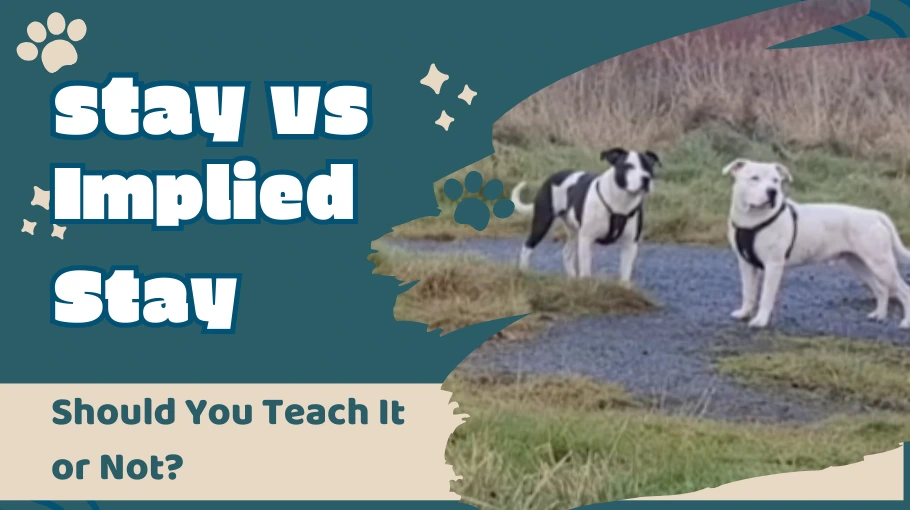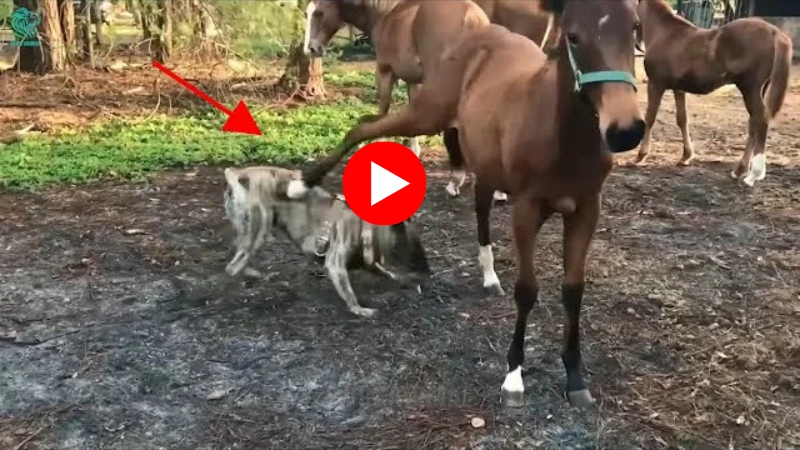“Stay” vs. Implied Stay: Should You Teach It or Not?

I was surprised to come across a rather heated online discussion: Why teach your dog stay? Should it be an actual command, or should it be implied when you tell your dog to sit or lie down?
I hadn’t given it much thought before. For me, “stay” (or in my case, “wait”) is a must-have command. And I’ll tell you why…
A Backup That Could Save Your Dog
Some people say cue, I say command. When I tell my dogs to do something, they don’t get rewarded until they follow through.
That might seem trivial at home. But outdoors? Especially if you’re walking off-leash? That backup command comes in handy. Really handy.
For me, “wait” is my version of “stay.” The word itself doesn’t matter—only that your dog recognizes it and obeys it. Teach them in Spanish if you like: Esperar.
Without “wait,” I’d be lost. Or rather, the dogs would be.
Why a Reliable ‘Stay’ is Essential for Your Dog’s Safety
The trails we walk are winding, tree-lined, and full of overgrown bushes—the perfect setup for adventure, and trouble.
On the other side? Who knows? Sheep, lambs, pigsties, or even horses. And horses? They kick.
No exaggeration. Here’s a video titled: “30 Brutal Deadly Kicks Of Horses That Make Dogs Dizzy And Collapse.” While I don’t love the commentary, the footage speaks for itself.
Real-Life Example: When “Wait” Saved the Day
One afternoon, I had our two Staffies out for a country stroll. We took a different route—this time on the far side of a familiar river.
The river was shallow enough to trot through. The only problem? The bank on our side had a slighly steeper drop. The big guy decided to go for it.
Trouble was, he’s a rubbish jumper.
He tried to get back up. Paws scrambled. He slid back down into the water. I saw the wheels turning in his head—the easy way out was across the river, into open fields.
But before he could bolt, I gave one firm command:
“Wait.”
He froze just long enough for me to kneel down, stretch out my arms, and cue him again:
“Up!”
A little butt-wiggling. One big leap. I grabbed his harness and pulled him over the ledge.
As soon as he hit solid ground, it was slobbery kisses and a wagging tail.
And that’s exactly why I wouldn’t rely on an implied “stay.”
What Does Implied Stay Even Mean?
In simple terms, implied stay means expecting your dog to “hold” a position without actually telling them to.
For example, you tell your dog to sit or lie down. Instead of giving a separate “stay” or “wait” command, you just expect them to stay put until you give a release cue.
Seems logical, right? But here’s where it gets tricky.
The Problem with Implied Stay
It’s easy to assume dogs just “get it.” Take this classic scenario:
You point to their mat and say, “Lie down.” They follow the command, you turn your back, and—boom—they’re up again. Why?
Because they’ve learned that your movement, not a verbal cue, is the release.
That’s how many new dog owners (myself included) unintentionally train implied stay. The dog holds the position… but only until they think they’re “done.”
Why I Teach ‘Wait’ Separately
With two Staffies, gentle strolls aren’t a thing. They run. Fast.
And being true to their Staffordshire Bull Terrier stubborn streak, when they get ahead of me on a walk, they’re not about to double back. If they see me walking toward them, their logic is:
“Why turn around? You’re coming this way anyway!”
That’s where “wait” comes in.
When they get too far ahead, I give the command—sometimes paired with a hand signal. They stop. They hold their position until I catch up.
This is especially useful on blind bends or narrow trails where I can’t see what’s ahead. A simple “wait” stops them from charging forward into who-knows-what.
But even if you never plan on off-leash walking, and prefer using a long-line leash for control, here’s something to keep in mind:
Dogs can be mini Houdinis.
A determined pup may very well wriggle out of a harness or slip a collar in seconds. And if that happens, do you really think they’ll come excitedly running back? So…
Is Teaching ‘Stay’ Extra Work?
Some owners skip “stay” to make training simpler. The thinking is: Why teach another command if the dog should already know to hold their position?
Here’s the problem—dogs don’t generalize as well as we think. Just because they hold a sit at home doesn’t mean they’ll do it outside with distractions.
By explicitly teaching “stay,” you remove the guesswork. Your dog knows: this is a command, not a suggestion. That clarity makes training more reliable, especially in real-world situations.
And if you want a solid recall, teaching a controlled stay is the logical first step.
Why ‘Stay’ is the Foundation of a Solid Recall
Teaching “stay” isn’t just about obedience—it’s about control and safety. Whether it’s preventing your dog from bolting across a road, stopping them from running into unknown territory, or simply keeping them calm when needed, a clear “stay” command removes the guesswork.
But here’s where it really pays off: recall training.
A dog who understands “stay” already knows how to pause, hold their position, and wait for your next cue. That same discipline is what makes a strong recall work. If your dog can stay reliably, they’re more likely to stop mid-run when you call them back—no hesitation, no second-guessing.
So if you want true off-leash confidence, or even just better control on walks, it all starts here.
Strengthen Your Dog’s Recall
If you’re ready to level up your recall training, check out my Ultimate Guide to Dog Recall Training where I break down:
✔️ Step-by-step methods to build a reliable recall
✔️ Common recall mistakes and how to avoid them
✔️ Training games to make learning fun for your dog
A strong recall is the most important skill you’ll ever teach your dog. And it all starts with a solid “stay.”
Read the Ultimate Guide to Dog Recall Training →
FAQs
“Is ‘Stay’ Different from ‘Wait’?”
Yes—“stay” means your dog holds their position until you release them. “Wait” is a temporary pause, often used to slow them down or stop movement briefly. Some trainers rely on an implied stay, while others teach wait as a separate command for boundary training and off-leash control.
“How Long Should I Train My Dog to Stay?”
Train for as long as needed for real-life situations. If you need your dog to stay while you open the car trunk and clip their harness, aim for at least a minute or longer. The goal is for them to stay put until it’s safe to move again.

